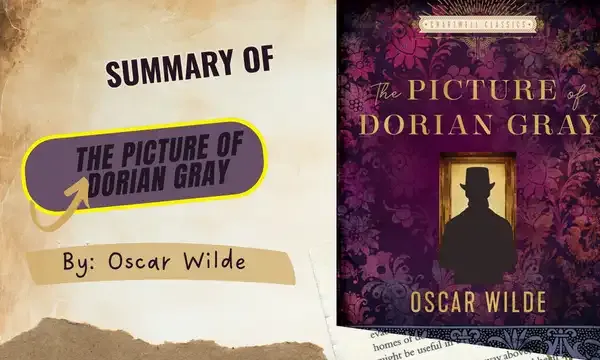The Picture of Dorian Gray by Oscar Wilde explores the corrupting influence of vanity and hedonism on human nature, highlighting the consequences of a life dedicated solely to pursuing pleasure and superficial beauty.
 |
| Summary of The Picture of Dorian Gray by Oscar Wilde |
The general idea of the book The Picture of Dorian Gray
- The Duality of Human Nature: Wilde presents the idea that there is a duality in human nature, with one's public persona and inner desires often at odds.
- Art as a Mirror: The novel underscores the power of art to reflect the true nature of a person, as Dorian Gray's portrait becomes a grotesque representation of his moral decay.
- The Pursuit of Pleasure: It critiques the hedonistic pursuit of pleasure at any cost, emphasizing the moral degradation that accompanies such a lifestyle.
Chapters of The Picture of Dorian Gray book
- The Picture of Dorian Gray: Introduces the main characters and sets the stage for the story's central premise: Dorian's portrait ages while he remains youthful.
- In the Studio of the Artist: Dorian becomes enamored with his portrait, realizing that it will bear the consequences of his actions, allowing him to indulge in a life of hedonism.
- The Sins of the Flesh: Dorian's decadent lifestyle begins, and he becomes obsessed with the pursuit of pleasure, indifferent to the moral consequences.
- The Portrait Ages: The portrait starts to show the physical effects of Dorian's sins while he remains unblemished, deepening his moral degradation.
- The Influence of Lord Henry: Lord Henry Wotton, a hedonistic and cynical character, significantly contributes to Dorian's descent into moral decay.
- The Peacock Room: Dorian's reckless behavior escalates as he continues to indulge in a life of vice, caring only about his own pleasure.
- Sibyl Vane's Tragedy: Dorian's callousness leads to the tragedy of Sibyl Vane, an actress who loves him, resulting in her suicide.
- The House of Orgy: Dorian becomes increasingly corrupt, participating in orgies and decadent parties.
- The Portrait Regains Youthfulness: Dorian's portrait miraculously regains its original beauty, while his own soul deteriorates further.
- The Picture is Destroyed: In a fit of rage, Dorian attempts to destroy the portrait, leading to his own demise.
- The Return to Innocence: Dorian tries to reform his life but ultimately fails as his past actions catch up with him.
- The End of Dorian Gray: The novel concludes with Dorian's death, while his portrait reverts to its original state, revealing his true nature.
Conclusions from The Picture of Dorian Gray book
- The pursuit of superficial beauty and pleasure can lead to moral decay and self-destruction.
- Art can serve as a mirror reflecting the true nature of an individual.
- The duality of human nature, with public and private personas, is a central theme.
- The consequences of one's actions eventually catch up with them.
About the author of The Picture of Dorian Gray
Oscar Wilde was a renowned Irish playwright, poet, and novelist known for his wit, flamboyance, and exploration of aestheticism. His background in literature and his personal experiences with the upper echelons of Victorian society informed his satirical and critical perspective in "The Picture of Dorian Gray."
The Picture of Dorian Gray in relation to other books
"The Picture of Dorian Gray" is often compared to other works of Gothic and moral literature, such as Mary Shelley's "Frankenstein" and Robert Louis Stevenson's "The Strange Case of Dr. Jekyll and Mr. Hyde." Like these works, Wilde's novel delves into the darker aspects of human nature
Audience of The Picture of Dorian Gray book
The novel is intended for a mature audience interested in moral and philosophical explorations of human behavior, art, and the consequences of hedonism.
Reception or Critical Response to the Book
Upon its initial publication in 1890, the novel received mixed reviews due to its controversial themes. However, it has since become a classic of English literature and is celebrated for its wit, style, and exploration of moral dilemmas.
Publication date of The Picture of Dorian Gray
"The Picture of Dorian Gray" was first published in Lippincott's Monthly Magazine in July 1890. It was later revised and expanded into a full-length novel, published by Ward, Lock & Co. in 1891.
Recommendations for other books
- "Frankenstein" by Mary Shelley: Explores themes of the consequences of unchecked ambition and the duality of human nature.
- "The Strange Case of Dr. Jekyll and Mr. Hyde" by Robert Louis Stevenson: Examines the dual nature of man and the moral implications of scientific experimentation.
- "The Great Gatsby" by F. Scott Fitzgerald: Explores themes of excess, hedonism, and the American Dream.
- "The Picture of Dorian Gray" by Oscar Wilde (1890): Offers a compelling examination of the corrupting influence of vanity and hedonism on human nature.

